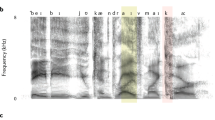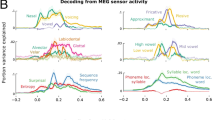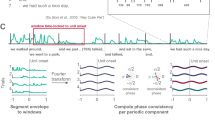Abstract
Humans effortlessly interpret speech and music, whose patterns can contain sound durations up to thousands of milliseconds. How nervous systems measure such long durations is unclear. We show here that model neurons containing physiological slow conductances are 'naturally' sensitive to duration, replicate known duration-sensitive neurons and can be 'tuned' to respond to a wide range of specific durations. In addition, these models reproduce several other properties of duration-sensitive neurons not selected for in model construction. These data, and the widespread presence of slow conductances in nervous systems, suggest that slow conductances might play a major role in duration measurement.
This is a preview of subscription content, access via your institution
Access options
Subscribe to this journal
Receive 12 print issues and online access
$209.00 per year
only $17.42 per issue
Buy this article
- Purchase on Springer Link
- Instant access to full article PDF
Prices may be subject to local taxes which are calculated during checkout




Similar content being viewed by others
References
Potter, H.D. Patterns of acoustically evoked discharges of neurons in the mesencephalon of the bullfrog. J. Neurophysiol. 28, 1155–1184 (1965).
Hall, J. & Feng, A.S. Neural analysis of temporally patterned sounds in the frog's thalamus: processing of pulse duration and pulse repetition rate. Neurosci. Lett. 63, 215–220 (1996).
Casseday, J.H., Ehrlich, D. & Covey, E. Neural tuning for sound duration: role of inhibitory mechanisms in the inferior colliculus. Science 264, 847–850 (1994).
Galazyuk, A.V. & Feng, A.S. Encoding of sound duration by neurons in the auditory cortex of the little brown bat, Myotis lucifugus. J. Comp. Physiol. A 180, 301–311 (1997).
He, J., Hashikawa, T., Ojima, H. & Kinouchi, Y. Temporal integration and duration tuning in the dorsal zone of cat auditory cortex. J. Neurosci. 17, 2615–2625 (1997).
Covey, E. & Casseday, J.H. Timing in the auditory system of the bat. Annu. Rev. Physiol. 61, 457–476 (1999).
Covey, E., Kauer, J.A. & Casseday, J.H. Whole-cell patch-clamp recording reveals subthreshold sound–evoked postsynaptic currents in the inferior colliculus of awake bats. J. Neurosci. 16, 3009–3018 (1996).
Ehrlich, D., Casseday, J.H. & Covey, E. Neural tuning to sound duration in the inferior colliculus of the big brown bat, Eptesicus fuscus. J. Neurophysiol. 77, 2360–2372 (1997).
Casseday, J.H., Ehrlich, D. & Covey, E. Neural measurement of sound duration: control by excitatory inhibitory interactions in the inferior colliculus. J. Neurophysiol. 84, 1475–1487 (2000).
Golowasch, J. & Marder, E. Ionic currents of the lateral pyloric neuron of the stomatogastric ganglion of the crab. J. Neurophysiol. 67, 318–331 (1992).
Huguenard, J.R. & McCormick, D.A. Simulation of the currents involved in rhythmic oscillations in thalamic relay neurons. J. Neurophysiol. 68, 1373–1383 (1992).
Lopez-Lopez, J.R., DeLuis, D.A. & Gonzalez, C. Properties of a transient K+ current in chemoreceptor cells of rabbit carotid body. J. Physiol. 460, 15–32 (1993).
Wang, W.Y., McKenzie, J.S. & Kemm, R.E. Whole-cell K+ currents in identified olfactory bulb output neurones of rats. J. Physiol. 490, 63–77 (1996).
Buckingham, S.D. & Spencer, A.N. K+ currents in cultured neurones from a polyclad flatworm. J. Exp. Biol. 203, 3189–3198 (2000).
Pape, H.C. Queer current and pacemaker: the hyperpolarization-activated cation current in neurons. Annu. Rev. Physiol. 58, 299–327 (1996).
Chen, C. Hyperpolarization-activated current (Ih) in primary auditory neurons. Hear. Res. 110, 179–190 (1997)
Bal, R. & Oertel, D., Hyperpolarization-activated, mixed-cation current (Ih) in octopus cells of the mammalian cochlear nucleus. J. Neurophysiol. 84, 806–817 (2000).
Hutcheon, B., Miura, R.M. & Puil, E. Models of subthreshold membrane resonance in neocortical neurons. J. Neurophysiol. 76, 698–714 (1996).
Angstadt, J.D. Persistent inward currents in cultured Retzius cells of the medicinal leech. J. Comp. Physiol. A 184, 49–61 (1999).
Kumamota, E. & Shinnick-Gallagher, P. Slow inward and late slow outward currents induced by hyperpolarizing pre-pulses in cat bladder parasympathetic neurones. Eur. J. Physiol. 416, 322–334 (1990).
Izhikevich, E.M. Neural excitability, spiking, and bursting. Int. J. Bifurcat. Chaos 10, 1171–1266 (2000).
Kanold, P.O. & Manis, P.B. Transient potassium currents regulate the discharge patterns of dorsal cochlear nucleus pyramidal cells. J. Neurosci. 19, 2195–2208 (1999).
Wu, M. & Jen, P.H.-S. Recovery cycles of neurons in the inferior colliculus, the pontine nuclei and the auditory cortex of the big brown bat, Eptesicus fuscus. Chin. J. Physiol. 41, 1–8 (1998).
Westheimer, G. Discrimination of short time intervals by the human observer. Exp. Brain Res. 129, 121–126 (1999).
Brand, A., Urban, A. & Grothe, B. Duration tuning in the mouse auditory midbrain. J. Neurophysiol. 84, 1790–1799 (2000).
Peruzzi, D., Sivaramakrishnan, S. & Oliver, D.L. Identification of cell types in brain slices of the inferior colliculus. Neurosci. 101, 403–416 (2000).
Sivaramakrishnan, S. & Oliver, D.L. Distinct K currents result in physiologically distinct cell types in the inferior colliculus of the rat. J. Neurosci. 21, 2861–2877 (2001).
Hooper, S.L. Transduction of temporal patterns by single neurons. Nature Neurosci. 1, 720–726 (1998).
Turrigiano, G., Abbott, L.F. & Marder, E. Activity changes the intrinsic properties of cultured neurons. Science 264, 974–976 (1994).
Itoh, K., Stevens, B., Schachner, M. & Fields, R.D. Regulated expression of the neural cell adhesion molecule L1 by specific patterns of neural impulses. Science 270, 1369–1372 (1995).
Fields, R.D., Eshete, F., Stevens, B.K. & Itoh, K. Action potential-dependent regulation of gene expression: temporal specificity in Ca+2, cAMP-responsive element binding proteins, and mitogen-activated protein kinase signaling. J. Neurosci. 17, 7252–7266 (1997).
Dolmetsch, R.E., Xu, K. & Lewis, R.S. Calcium oscillations increase the efficiency and specificity of gene expression. Nature 392, 933–936 (1998).
Li, W., Llopis, J., Whitney, M., Zlokarnik, G. & Tsien, R.Y. Cell-permeant caged InsP3 ester shows that Ca+2 spike frequency can optimise gene expression. Nature 392, 936–941 (1998).
Muschol, M. & Salzberg, B.M. Dependence of transient and residual calcium dynamics on action-potential patterning during neuropeptide secretion. J. Neurosci. 20, 6773–6780 (2000).
Hodgkin, A.L. & Huxley, A.F. A quantitative description of membrane current and its application to conduction and excitation in nerve. J. Physiol. Lond. 117, 500–544 (1952).
Huguenard, J.R. & McCormick, D.A. A model of the electrophysiological properties of thalamocortical relay neurons. J. Neurophysiol. 68, 1384–1400 (1992).
Acknowledgements
We thank E. Covey for helpful discussions. This work was supported by the Neuroscience Program at Ohio University and the US National Institutes of Mental Health.
Author information
Authors and Affiliations
Corresponding author
Ethics declarations
Competing interests
The authors declare no competing financial interests.
Supplementary information
Rights and permissions
About this article
Cite this article
Hooper, S., Buchman, E. & Hobbs, K. A computational role for slow conductances: single-neuron models that measure duration. Nat Neurosci 5, 552–556 (2002). https://doi.org/10.1038/nn0602-838
Received:
Accepted:
Published:
Issue Date:
DOI: https://doi.org/10.1038/nn0602-838
This article is cited by
-
Control of firing patterns by two transient potassium currents: leading spike, latency, bistability
Journal of Computational Neuroscience (2011)
-
Duration tuning in the auditory midbrain of echolocating and non-echolocating vertebrates
Journal of Comparative Physiology A (2011)
-
Role of hyperpolarization-activated conductances in the lateral superior olive: A modeling study
Journal of Computational Neuroscience (2006)



